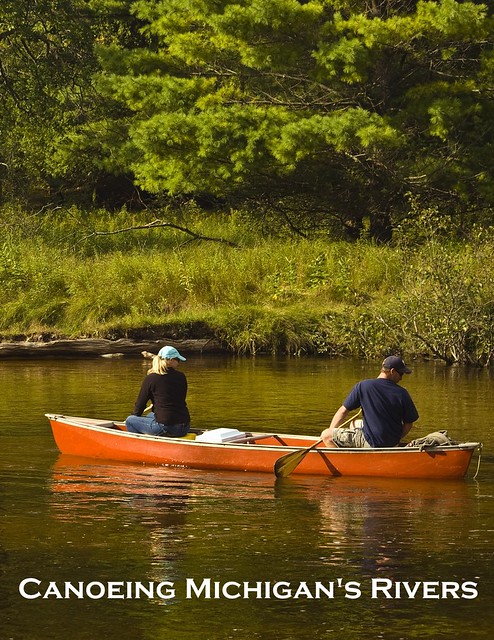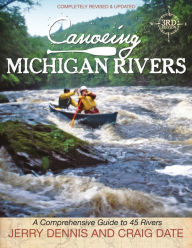Canoeing - it sounds romantic, doesn't it? My aunt and uncle had their first date while canoeing a Michigan river. My parents gave my husband and I a double kayak for our wedding present. I am a nature photographer, and most of my photographs are taken out on the lake, during a quiet paddle. Every other week our daughter and I go out and clean up the lake, picking up people's trash.
It is all about the water, and how you can truly experience nature by being on it.

I have been treasuring a book from Thunder Bay Press, entitled Canoeing Michigan Rivers: A Comprehensive Guide to 45 Rivers, Revised and Updated, by Jerry Dennis and Craig Date. It is jam-packed with great details - lists by rivers, start to finish, counties, miles/time, gradient, portages, rapids/falls, campgrounds, canoe liveries, skill levels required, and permits required. They have a nice introduction to each river, for both the Upper and Lower Peninsula. It is one of the best guidebooks I've ever read! One of my uncles used it last weekend, while he was out canoeing, and just loved it (no, I don't have my copy back yet...). I was lucky enough to sit down and talk with Jerry about their book - and what a fun interview it was! Here's what he had to say..
WE: Please tell us about your book, Canoeing Michigan Rivers.
JD: I'm proud of this book, my first literary child, which I wrote with my great old friend, Craig Date. We were college housemates in the late 1970s, in Marquette, Michigan, and at every chance canoed, camped, fished, and played bluegrass music (I was English-Lit and mandolin, he was Social Work and guitar). In January 1984, while canoeing the Pine River one frigid weekend with a group of old friends, we realized that nobody had ever written a paddling guide to Michigan.
I was eager to write a book (and had already begun sketching out the personal essays that would later become "A Place on the Water") and Craig and I were both excited about exploring new waters, so we set out in high spirits to make the best book we possibly could. First, though, we had to con a publisher into believing that we were a professional writer/photographer team, when, in fact, I had published only a few articles in local magazines and Craig had never owned a camera.
The publisher, Gary Barfknecht, at Friede Publications, was a terrific sport about it when we confessed to the deception a year or so later. He then confessed, in turn, that the "staff" he had told us was impressed with our proposal and was excited about publishing our book, was, in fact, just him, a one-man operation, and that we were the first authors he signed. We immediately became friends for life. The book was a smash hit, by regional-book standards, and gave me the confidence to quit my job and become a full-time writer. Craig went on to become an accomplished photographer and a long-distance truck driver. Twenty years and several updated editions later -- and, now that Gary Barfknecht has retired, a wonderful new publisher -- Canoeing Michigan Rivers is still considered the "bible" of Michigan paddling. And though I've published many other books and have enjoyed writing all of them, none has been as flat-out fun as that first one.
WE: What is your favorite river to canoe? The most challenging?
JD: I'm partial to the rivers of the northern Lower Peninsula, my home waters, all of which are quick-spirited, clean, clear, and stunningly beautiful. The Boardman is my hands-down favorite, but I'm very fond also of the Manistee, Au Sable, Pine, and Sturgeon. The most challenging is the Presque Isle, in the western U.P., a river that Canoe Magazine once listed as among the ten most challenging east of the Mississippi.
WE: How long did it take you to research this book?
JD: Craig and I always referred to the research as "research," in quotes, and would have done it whether we got paid or not. For two years we spent almost every weekend plus several week and two-week periods traveling the state to paddle the lengths of 45 rivers -- about 1,500 river miles in all. Often we were joined by my wife, Gail, and our son, Aaron, who was just old enough to appreciate the adventure. Our youngest son, Nick, went along in embryo, which is surely why he has always loved the water. The "research" took twice as long as we'd expected, but we didn't mind. It became a lifestyle, and we missed it when it was over.
WE: If someone is just starting up with canoeing, how do you recommend they begin?
JD: It doesn't take much. A little one-on-one tutoring from an experienced friend, a day on the water, and you're on your way. Many outfitter shops and local paddling clubs offer free paddle days, which are a great way to learn basic strokes and try out a variety of boats to find the one that suits your needs. Also many colleges offer paddling as a community-ed program.
WE: Do you prefer kayaks or canoes, and in which settings would one be better?
JD: I'm a canoe guy, because I grew up paddling them and was enamored with the north-woods tradition, and because I like to camp and fish and appreciate being able to carry all the gear I want. Kayaks are terrific fun, however. In big water, such as the Great Lakes or the ocean coasts, a touring kayak is much faster and safer than an open canoe. And paddling a whitewater kayak in a class-III or higher rapids is the aquatic equivalent of hang-gliding and more fun than anything. But for backcountry lakes and most rivers, I'll take a canoe.

WE: What are some safety factors people need to consider?
JD: First, foremost, and always, a PFD (personal floatation device). Don't even consider not wearing one. Wet- or dry-suits are essential for cold weather on whitewater rivers, and helmets are necessary in whitewater. In backcountry -- even just a few miles back -- it's a good idea to carry a waterproof tote bag with matches, dry clothes, and a first-aid kit.
WE: Is there anything else you'd like to share with us?
JD: Canoeing and kayaking can save the planet. Truly. All my books have in one way or another examined the ways we become engaged in work and play and places, and how those experiences can help us live more fully, with greater awareness of what's happening around us, and a deeper appreciation of nature, both human and wild. Ride the current on a river and you'll defend that river when it's in trouble. Fall in love with it, and you fall in love with the world.
WE: Wow, Jerry! We have kayaks, and I have resolved to get out in them more often, on our lake. Thank you so much for this interview - very inspiring! I am still laughing over your first publisher and you two, and the fancy dance you all did.
Click the photo to purchase it from Barnes & Noble:
Rapid by rapid, rock by rock descriptions of 1500 miles of canoeing opportunities on 45 blue-ribbon rivers by two experts who personally paddled every mile. A wealth of canoeing adventures from placid family floats to blood-curdling whitewater runs.

